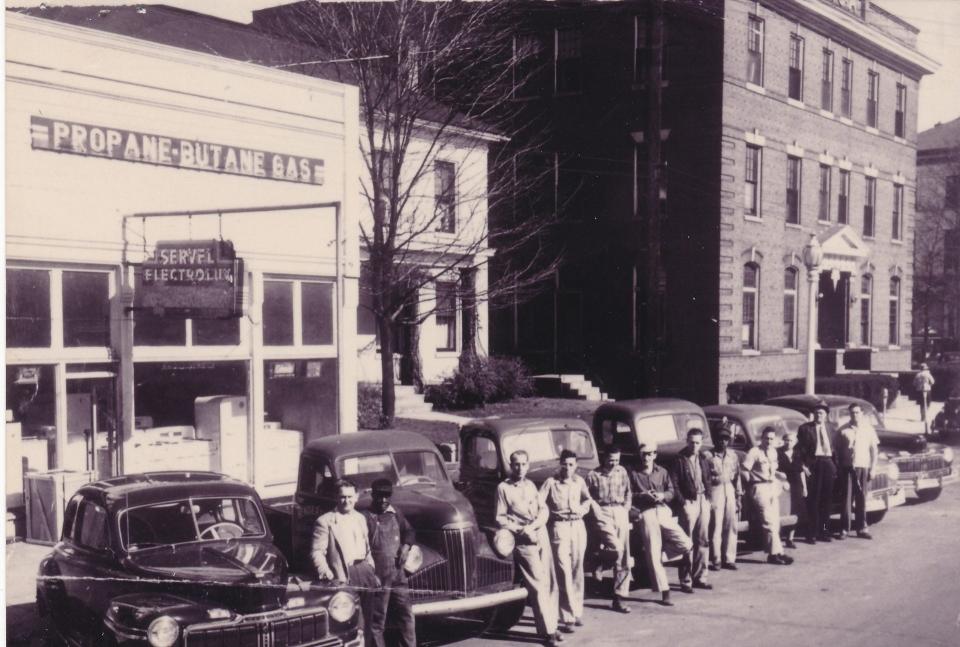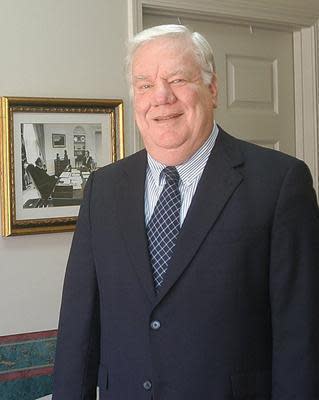Henderson history: Television flickered on in Henderson in 1948
HENDERSON, Ky. − Crowds gathered just about every evening in 1948 to peer through the display window of the Henderson Gas Appliance store to watch a jittery box of magic called television.
They’d been hearing about it for years; several inventors had demonstrated crude versions by the late 1920s. RCA unveiled its TV during the 1939 World’s Fair in New York City and went to lengths to prove it wasn’t a hoax. It built TVs with a transparent case around the workings and allowed fairgoers to see themselves on the screen. RCA even handed out cards certifying fairgoers had been televised. Several other firms also demonstrated television.
World War II intervened but immediately afterward there was a mad rush for broadcast licenses. Wayne Coy, chairman of the Federal Communications Commission, said in The Gleaner of June 4, 1948, that there were only 28 TV stations on the air at that point. However, there were another 72 under construction and 237 had applied for licenses.

One of those early stations was KSD in St. Louis, which began broadcasting Feb. 8, 1947. Special antennas and a combination of good luck and favorable weather were required to pick up a watchable signal in the Tri-State area, however, and that didn’t come right away.
Hugh Edward Sandefur’s first work for The Gleaner was a column called, “It’s In The Air,” which detailed upcoming radio programs. I suppose it was a natural fit that he would be the first local journalist to start paying attention to TV.
As early as May 23, 1948, he wrote, “The old-time vaudeville show will make a comeback over the television airwaves, when the Star Theater begins its run on the seven-station East Coast television network June 8.” Milton Berle was to emcee the variety show.
More: Henderson history: Bull Island promoter tried for a 1973 encore in Tri-County area
A couple of weeks later, on June 8, The Gleaner carried a story proclaiming that Jack Grimes of 236 Highland Drive had Henderson’s first TV set, which he had built himself. It had a 10-inch screen.
Grimes and his friend, Neff Cox of Evansville, picked up station KSD with their home-made antenna and over the first week they watched baseball games between Brooklyn and St. Louis, as well as wrestling matches.
Sheffer Electric Co. also was alert to the possibilities of television. An advertorial in The Gleaner of July 28 urged those proposing to build a house to plan for adequate lighting and extra plug-ins. “The steps also will take care of any installation that you may be planning for the future, among them television.”
The Gleaner of July 30 announced WAVE-TV in Louisville had affiliated with NBC, although it did not go on the air until Nov. 24. WAVE was Kentucky’s first television station.
Grimes was manager of Henderson Gas Appliance at 227 N. Main St. and as of Aug. 13 it began advertising the sale of TV sets “priced from $179.50, plus antenna and installation.”
Using the locally designed antenna, Grimes promised “reception which has heretofore been considered impossible.”
Grimes got pretty hot when Ed Klinger of the Evansville Press wrote an article saying television was a “stunt” and still in its infancy. As of 1948, Klinger wrote, television in Evansville was simply not practical.
Grimes took his complaints to Jack Hudgions of The Gleaner, who wrote a response that appeared Aug. 29.
“What Evansville can’t do … Henderson has already done. And we’re speaking of television,” Hudgions’ article began, noting a TV set had been operating in the display window of Henderson Gas Appliance nearly every evening.
Hudgions wondered what Klinger was talking about.
“I wondered why hundreds of Hendersonians would take time out to go down on Main Street, across from the Kraver Theater, and stand hour upon hour to watch a ‘lousy’ program zip across a glass screen. I wondered why they would want to watch a ‘baby’ several hours each night.”
Hudgions knew why. He had seen baseball great Stan Musial increase his batting average. He had seen “Ralph Garibaldi, a favorite grunt and groan performer at Evansville’s Coliseum, perform before several thousand St. Louis fans.”
Hudgions conceded there was a difference between reception in Evansville and that in Henderson, but he attributed it to the antenna Grimes was using. And you didn’t have to stand in the street to see the evidence. J.V. Gasser had installed a TV set and the local antenna in his house and had no complaints.
Evansville soft drink bottler A.J. Hillenbrand at first tried an antenna he had obtained from an Evansville dealer but his dissatisfaction prompted him to give Grimes a try. “And the other night, when other Evansville television owners said it was ‘impossible’ to get clear pictures, Mr. Hillenbrand and friends were watching the Boston Braves whip the St. Louis Cardinals 2 to 0.”
Henderson History: Last barrels of Henderson-made whiskey shipped out 100 years ago
Finas Tapp, proprietor of The Brass Rail at 107 N. Main St. had also installed a television set, which carried the World Series game Oct. 10. (There was a later backlash against TV by some tavern owners because gawkers at the bar would sometimes crowd out paying customers.)
Despite all the hoopla, however, it appears in hindsight Klinger was more correct than Hudgions gave him credit for. Sandefur wrote a front-page story in The Gleaner of Dec. 27, 1953, that began, “Television came to the Tri-State in 1953.”
WEHT – the Tri-State’s first television station and the third in Kentucky – had started broadcasting a test signal Sept. 13, 1953, but didn’t begin actual programming until Sept. 27. It was quickly followed Nov. 15 by WFIE. Programming ran from 5 p.m. to 11:30 p.m. in the beginning.
When Sandefur wrote his story about TV’s local impact, he noted, “it is still too soon to measure its full import on an area that heretofore had been considered ‘fringe’ and only those who could afford an expensive hobby had sets…. It is only since the signing on of local stations that the set owner can be sure of getting full value in reception from his investment.”
By the end of 1953, Sandefur estimated “that there are still less than one-third of the homes television equipped.”
And many of those had pooled their entire Christmas budget to buy something the whole family wanted. “One local loan company financed 90 television sets in one day.”
Sandefur said TV had made a big buzz for being around such a short time. He quoted the manager of the local J.C. Penney store, who noted the store was full of Christmas shoppers the entire day – until the TV stations began broadcasting at 5 p.m.
And law enforcement officers – city, county, and state – “have observed a marked decrease in nighttime traffic on local streets and highways.”
But it was still too soon to judge how much television had changed society.
“By next Christmas it will no longer be a novelty and it is then we will be able to judge whether it will greatly alter the pattern of social behavior.”
100 YEARS AGO
Henderson’s new bus line was not garnering the type of patronage the owners had hoped for, judging from The Gleaner of Aug. 1, 1923.
Two Dodge buses were operating on the route from the East End to Atkinson Park, but a seven-passenger touring car was being used on the route to the fairgrounds on South Green Street, mostly because of the street conditions.
The previous day, the story said, the bus line racked up 156 miles to serve 137 people.
50 YEARS AGO
Peabody Coal Co. was in the process of developing a new underground coal mine between what was then the Anaconda Aluminum smelter and the Big Rivers power plant, according to The Gleaner of Aug. 3, 1973.
The entrance to the Panama Mine was about 300 feet from the power plant’s coal stockpile, which was estimated to produce about two million tons annually for the utility.
Construction was expected to take about two years and full production wasn’t expected for three years, at which time approximately 300 people would be employed.
The mine was shut down in mid-1976 because of the refusal of Big Rivers to use what it called low-quality coal. However, Big Rivers bought the mine in April of 1977.
25 YEARS AGO
Carroll Hubbard, who died last year, was attempting to rebuild his life after serving two years in prison, according to The Gleaner of Aug. 5, 1998.
Western Kentucky’s longtime U.S. representative was elected state senator in 1967 and in May 1974 defeated U.S. Rep. Frank Stubblefield in the Democratic primary for the 1st Congressional District. He served in Congress for nine consecutive terms.

He was defeated in 1992 after he had been caught up in the House banking scandal. In 1994 he pleaded guilty to federal felony charges involving misuse of campaign funds and congressional employees. He was disbarred, but the Kentucky Supreme Court reversed that action.
Readers of The Gleaner can reach Frank Boyett at YesNews42@yahoo.com, on Twitter at @BoyettFrank, and on Threads at @frankalanks.
This article originally appeared on Evansville Courier & Press: Henderson history: Television flickered on in Henderson in 1948

